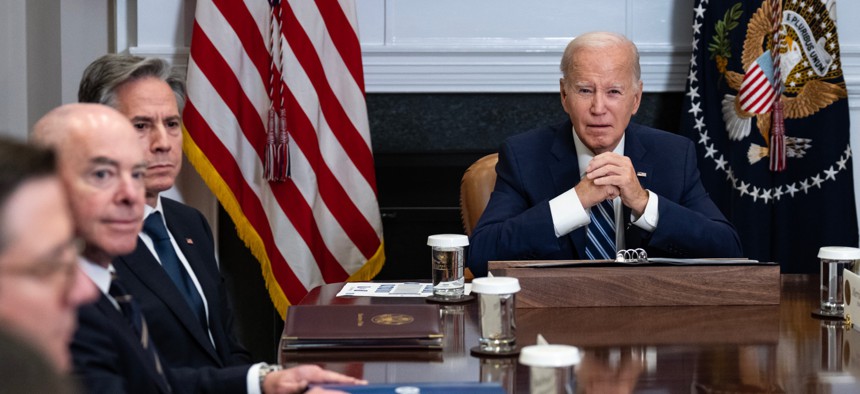
President Biden's cabinet has seen only two members in the line of succession leave since 2021. Drew Angerer / Getty Images
The Biden administration has far less turnover than Trump. Does that impact agency performance?
The stability of Biden's cabinet and sub-cabinet is a marked departure from his predecessor.
At this point in the previous administration—March of 2020—President Trump had already seen 10 of his cabinet members in the line of succession depart. He would go on to see 14 total of the agency heads leave by the time his term expired.
That was an unusual figure, with the former president’s mercurial nature and public humiliations of his top officials contributing to the tumult of his administration.
Last week, then-Housing and Urban Development Department Secretary Marcia Fudge retired. By contrast to his predecessor, that marked just the second cabinet member in the line of succession that President Biden has lost. Since President Reagan, that is tied for the lowest total for a first-term administration with President George W. Bush, according to a database maintained by the Brookings Institute’s Kathryn Dunn Tenpas. Biden has lost only a handful of deputy secretaries, including at the departments of Agriculture, State and Interior.
Cristóbal Alex, Biden’s former deputy cabinet secretary who led coordination efforts between the White House and the rest of the executive branch, said the relative leadership stability has been fundamental to the current administration’s capacity to carry out its priorities. Inside the White House’s Presidential Personnel Office, he said, the key motto is that “people are policy.” The president cannot enact his vision without trust in their competence and experience, which can be difficult to establish.
“The president has to trust them and senior staff,” Alex said of the cabinet and sub-cabinet. “Once you have it, they’re in sync. They follow the president’s leadership and get the job done.”
He added that having lasting relationships with officials at agencies made his job easier, and in turn the jobs of career employees easier as well.
“No two days are the same at the White House,” said Alex, now at Tusk Strategies. “A lot of pressure and things move quickly, and having the trust is what allows you to pick up the phone and deal with an issue.”
The relationships also help to “build new muscle” when the administration has to stand up new programs, with Alex citing as an example the constant interfacing between the White House and the Commerce Department as it rolls out the CHIPS and Science Act
Tenpas, at Brookings, said she wanted to track the presidential turnover data because more people should pay attention to the key players making consequential decisions.
“The portfolio of the president is so vast, no president can have expertise in every issue,” Tenpas said, adding it forces presidents to lean on advisers and cabinet officials. “We should know more about them. We should care about them.”
When turnover is high, she said, it impacts the functioning of government as it would any private sector entity. Long-range planning becomes difficult, anxiety breeds in offices and trust in management suffers. The wheels on the bus will keep turning, Tenpas said, but morale sinks and performance worsens. Career employees’ focus can shift from mission activities to concerns over whether new leadership will institute organizational changes or cuts.
An administration official, granted anonymity to discuss personnel matters, said Biden has incentivized his team to stay by empowering it.
“Over the last three years, the president has entrusted his cabinet and senior officials throughout the administration, to travel the country and share how the Biden-Harris agenda is helping all Americans, including by lowering costs for Americans, investing in our infrastructure and creating millions of good-paying jobs,” the official said.
Tenpas suggested Biden’s long career helped him develop a team that he knew would stick around.
“He’s been in politics for so many years, he knows how to pick staff and knows who he trusts,” she said.
He has largely not relied on Trump's tactic of appointing temporary leaders and tapping appointees to serve in multiple roles simultaneously. Tenpas said Biden has effectively ensured that whenever a post is vacated, a replacement is lined up. At the cabinet level, the president has nominated Labor Department Deputy Secretary Julie Su to replace Marty Walsh while he has not yet named a successor for Fudge at HUD.
There are roughly 1,200 positions in federal government requiring Senate confirmation. The Partnership for Public Service tracks 727 non-termed key roles within that total and Biden has seen 569 of those filled with confirmed leaders. Several dozen are currently awaiting Senate action, though he has yet to nominate anyone for 92 positions. The Partnership has long called for reforms in the number of appointments, suggesting long wait times for lower-level nominees are hurting agency management and undermining congressional oversight.
All presidents must also fill their White House staff, which Tenpas designates as the “A Team.” Biden has seen 71% turnover in those roles, below the 92% that occurred under Trump but in line with the previous five presidents.
Still, Alex said the consistency at the agency level, coupled with the president’s regular praise for the career civil service, has improved the functioning of government.
“It is reflected in the work product and outcomes from agencies,” Alex said.







